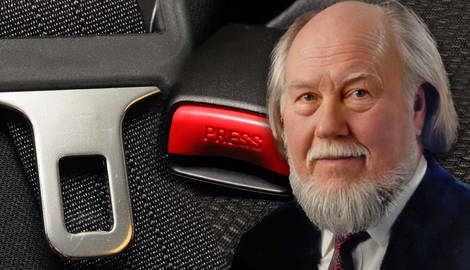
In 1959 Nils Bohlin, a mid-level engineer, invented the three-point seatbelt. The German patent registrar called his invention one of the eight most important patents that aided humanity in the late 1800s to late 1900s. At the time of invention, cars only used a two-point belt. The original seatbelt had been invented by Sir George Cayley in the 19th century. These belts went across the waist, buckling the driver or passenger in. This usually prevented people from getting ejected out of the seat and through the windshield.
Early Seatbelts and Injuries

While early, two-point seatbelts were certainly revolutionary and life-saving, whiplash, facial injuries on the dash or wheel and internal injuries were still prevalent because of the restraint only being around the waist. Not to mention, unless you drove professionally (such as racing) many people didn’t wear seatbelts, increasing the amount and severity of injuries.
According to the National Safety Council (NSC), in the 1913 there were over 4,000 deaths in the United States related to automobiles. This number skyrocketed to almost 40,000 in the 1930s, presumably from faster cars, and more people on the road thanks to companies like the Ford Motor Company producing affordable cars. The early 1900s also saw the beginnings of racing circuits.
Nils Bohlin & the Creation of the Three-Point Belt

Bohlin was born in Sweden on July 17, 1920. He began as a designer and engineer after graduating as a mechanical engineer in 1939 from Härnösand Läroverkj. His first job wasn’t in the car industry, but in aviation, which is perhaps where he gained an understanding on the importance of harnesses and belts for safety. His job? Working on airplane ejection seats for a company called Saab AB, a Swedish aerospace and defense company. Saab themselves would begin producing automobiles in 1947, starting off as a joint venture with General Motors. Bohlin began working at Volvo in 1958 as a safety engineer.
There was a y-shaped belt shortly before Bohlin’s design, however it hooked in the front of the occupant by the belly not the side of the hip with focal points being on the shoulder, chest, and pelvic bone. Unlike two-point lap belts, newer versions were easier to use, because they could be buckled and unbuckled easily with only one hand.

It took Bohlin almost a year to finish his finessed version of the three-point seatbelt before presenting it to the company. This was due to the many considerations he had to put in, such as the cost to make and manufacture the belt, its ease of use, and its efficiency.
Safety First: Volvo

Volvo is a well-known Swedish luxury car brand. They were founded by Assar Gabrielsson and Gustav Larson 1927 in Gothenburg, Sweden. Several years earlier, the founders had met at a restaurant in Stockholm with the idea of creating and operating a car company. Their goal was to create a car that would be safe in a country with rough terrain and temperatures that were colder. Imported vehicles from other countries couldn’t handle the conditions in the long term and would break down more often.
A famous statement released by the two founders says that “cars are driven by people. The guiding principle behind everything we make at Volvo, therefore, is and must remain, safety.”
While the three-point seatbelt remains one of the most ubiquitous inventions to be released by Volvo, they also introduced patents of other safety innovations which would later be used in car manufacturers across the world, including the implementation in 1978 of a child booster seat for older children facing forward, a creation of a rear facing child seat in 1972 for the front seat of a car, side impact protection system (SIPS), and eventual side impact airbags in 1994. Their website still offers crash-research data for anyone to access.
The Invention that Changed it All

The first Volvo to be sold with a three-point seatbelt was a Volvo PV544 August 13, 1959. While the design is officially patented (number 3,043,625) Volvo and Bohlin let the invention be open sourced which meant other car companies would be able to utilize the safer design, prioritizing the safety of lives versus money.
While there have been some changes and improvements to the original design, at the core of the three-point seatbelt remains Bohlin’s design. Wisconsin became the first state to require seatbelts in cars in 1961, which expanded to the entire country in 1968 thanks to the 1968 National Traffic and Motor Vehicle Safety Act. Nowadays the act of clicking the seatbelt when getting in a car is a muscle memory most take for granted, and it is easy to forget how important seatbelts are and how many lives they save until there is an accident.

For his work on the three-point seatbelt, Bohlin was awarded the Ralph Isbrandt Automotive Safety Engineering Award in 1974 and inducted into the Hall of Fame for Safety and Health in 1989. He died in Sweden September 26, 2002.









